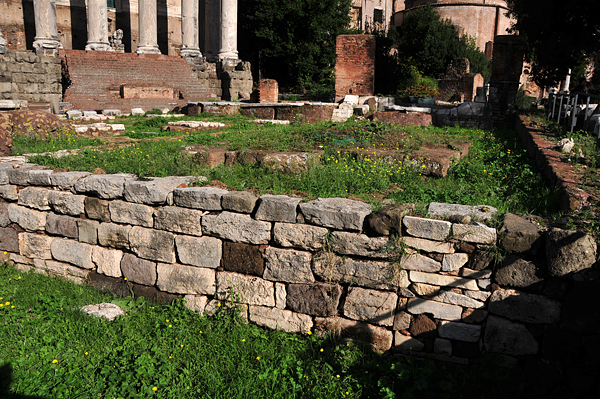

The wedge-shaped area between the Temple of Vesta and the Temple of Antonius Pius and Faustina marks the site of the Regia, thought by the Romans to have been the residence of their early kings, beginning with the second, Numa Pompilius (Plutarch, Life, XIV.1), who donated it to the Pontifex Maximus, the chief priest and the administrative and spiritual superior of the Vestal Virgins. The Regia was considered a sacred space and, although the seat of authority, was not where the pontiff lived. That house was the domus publica, which originally was part of the House of the Vestals until Augustus assumed the office in 12 BC and moved the official residence to the Palatine. Caesar lived in the domus publica for almost twenty years, when he assumed the office of Pontifex Maximus in 62 BC (which allowed him to move from his unfashionable quarters in the Subura). That year, the festival of the Bona Dea was celebrated and it was where Publius Clodius Pulcher, disguised as a woman, was caught trying to seduce Caesar's wife. The Regia also was where records and documents were kept, the annals and calendar, and where the college of pontiffs assembled.
The curious trapezoidal shape was an attempt to maintain the building's east-west orientation and still fit behind the Temple of Divine Julius. The name, itself, suggests an ancient connection with the kings of Rome and, in honor of its antiquity, subsequent rebuilding conformed to the original design. There were restorations in 210 BC and 148 BC, and by Cnaeus Domitius Calvinus in 36 BC from the spoils of his victory in Spain that year (Dio, XLVIII.42.4-6). It may have been then that Calvinus decorated the outside walls with lists of the consuls and triumphators from Romulus to Augustus (fasti consulares et triumphales) that were found nearby and now are in the Palazzo dei Conservatori. Splendidly adorned, including statues borrowed from Caesar which, when they were not returned, were offered instead as votive offerings, the thick marble walls possibly protected against the fires of AD 64 and AD 191. The House of the Vestals was destroyed in the fire of Nero (Tacitus, Annals, XV.41, which also says that the Regia was lost). When the Atrium Vestae was rebuilt, its cardinal alignment with the Temple of Vesta and the Regia was disregarded.
The Regia had three rooms, the largest a shrine to Mars, who both was a god of agriculture as well as war. Here were held hia shield, said to have fallen from heaven (Plutarch, Life of Numa, XIII.1ff), and the spears, which were clashed together before a campaign began and the god roused by the cry Mars vigila, "Mars awake!" (Servius, Commentary on the Aeneid of Virgil, VIII.3.1). These sacred weapons, removed to the domus publica where Caesar resided after being elected Pontiff, were said to have "made a great noise at night," portending his assassination the next day (Dio, XLIV.17.2). A shrine to Ops Consiva (from conserere, "to sow"), the consort of Saturn and goddess of plenty, was so sacred that only the Pontifex Maximus and Vestal Virgins were allowed to enter (Varro, De Lingua Latina, VI.3). Here, on August 25, her annual harvest festival and the storage of crops were celebrated. Between the chapels, a vestibule opened onto a courtyard, where two sacred bay trees grew.
A remnant of the monarchy was the role of the rex sacrorum, who as "king of sacred rites" oversaw religious observances traditionally performed by the king. And yet, "lest he should become king in anything more than name, and so threaten that liberty which was their first care, his office was made subordinate to the Pontifex Maximus" (Livy, II.2.1; also Dionysius of Halicarnassus, IV.74.4; V.1.4).